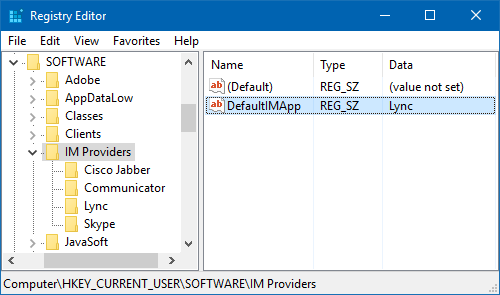
- Skype for business not connecting to outlook full#
- Skype for business not connecting to outlook code#
From Lync Management Sell, run the following: Now that we know our “ OnMicrosoft” domain, we can configure Lync to communicate with it:įirst, we’ll create a new Hosted Voicemail Policy. Whatever your domain is (for example: ), this is what we’ll use in the following steps: This is the one we’re going to use to communicate with Office 365. What we’re looking for is the original “. Now that you’re connected to Office 365, run: Get-Mailbox, to see you recognize what’s going on, and then run: Get-AcceptedDomain. You should end up with an output similar to this: You might receive a warning saying “ WARNING: Your connection has been redirected to the following URI: $365 = New-PSSession -ConfigurationName Microsoft.Exchange -ConnectionUri -Credential $cred -Authentication Basic –AllowRedirection

This will pop up a credential prompt, enter your Office 365 administrator credentials and press Ok:

Run: $cred = Get-Credential and press Enter. To do so, open a new elevated PowerShell window and connect to Office 365 using the following steps: To continue configuring Lync on premises, we need some details about the Office 365 domains and tenants. Get-CsHostingProvider -LocalStore, this should be the result: Get-CsManagementStoreReplicationStatus (If replicated to all, should be “UpToDate: True” on all servers),Īnd last, check that it’s configured and displayed correctly by running: Verify that it’s replicated to the Edge server by running: This has configured your Edge server to be able to communicate with Office 365. New-CsHostingProvider -Identity “Exchange Online” -Enabled $True -EnabledSharedAddressSpace $True -HostsOCSUsers $False -ProxyFqdn “exap.um.” -IsLocal $False -VerificationLevel UseSourceVerification Now, add Office 365 Exchange Online as a new hosting provider: Set-CsAccessEdgeConfiguration -AllowFederatedUsers $true -EnablePartnerDiscovery $true -UseDnsSrvRouting If one of the parameters is missing, run the following command: RoutingMethod (Should be set to UseDnsSrvRouting).EnablePartnerDiscovery (Should be set to True).AllowFederatedUsers (Should be set to True).You’re looking for the following parameters: From an elevated Lync Management Shell, run the following command: Start with finding out your current configuration. Not a big deal, just make sure you double-check everything for typos… We’ll be using mostly PowerShell (Lync Management Shell) to configure this. In “Transfer and Search”, I normally change the “Allow callers to search…” to “In the entire organization”:Ĭlick “Save”, and this part of the configuration is done! Add ‘*’ in “Number pattern” and “Dialed Number”:Ĭlick “OK” to save and go to “Dialing Authorization”.Next, go to “Settings” and configure as desired:Ĭontinue to Dialing rules: You can leave this as it is, or add a rule to allow Outlook to play on phone:Ĭlick the ‘+’ sign to add a new dialing rule: Reason is that Outlook voice Access will only correspond to matching numbers, and you would like to have this configured as well: On the next box, “Outlook Voice Access numbers”, enter the number you entered for the previous box, and the regular display number (e.g. This is where you enter your Subscriber Access number in an E.164 format. Keep the default greeting and announcement unless you have a pre-recorded file, and go to “E.164 routing numbers for your SIP server”. If it’s ok – continue to “dial codes” and enter your country\region code. These are not changeable, so if you made a mistake, now would be a good time to start things over. View your settings in the “General” page. You now have a new Dial plan, click “Configure” to continue:
Skype for business not connecting to outlook code#

Skype for business not connecting to outlook full#
This post will guide you through the steps required to configure Hosted UM on Office 365 for an on premises Lync deployment.Ĭonsidering you have a full Lync \ S4B 2013 enterprise voice solution already deployed in you organization, additional prerequisites for this would be: As Office 365 is becoming more and more popular with larger organizations, many Lync \ S4B customers would like to host their voicemail in the cloud.


 0 kommentar(er)
0 kommentar(er)
